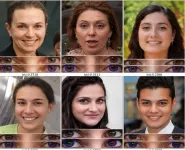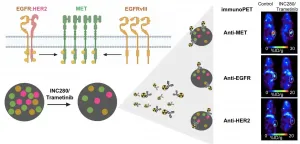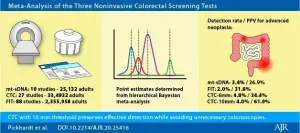INFORMATION:
How to spot deepfakes? Look at light reflection in the eyes
University at Buffalo deepfake spotting tool proves 94% effective with portrait-like photos, according to study
2021-03-12
(Press-News.org) BUFFALO, N.Y. - University at Buffalo computer scientists have developed a tool that automatically identifies deepfake photos by analyzing light reflections in the eyes.
The tool proved 94% effective in experiments described in a paper accepted at the IEEE International Conference on Acoustics, Speech and Signal Processing to be held in June in Toronto, Canada.
"The cornea is almost like a perfect semisphere and is very reflective," says the paper's lead author, Siwei Lyu, PhD, SUNY Empire Innovation Professor in the Department of Computer Science and Engineering. "So, anything that is coming to the eye with a light emitting from those sources will have an image on the cornea.
"The two eyes should have very similar reflective patterns because they're seeing the same thing. It's something that we typically don't typically notice when we look at a face," says Lyu, a multimedia and digital forensics expert who has testified before Congress.
The paper, "Exposing GAN-Generated Faces Using Inconsistent Corneal Specular Highlights," is available on the open access repository arXiv.
Co-authors are Shu Hu, a third-year computer science PhD student and research assistant in the Media Forensic Lab at UB, and Yuezun Li, PhD, a former senior research scientist at UB who is now a lecturer at the Ocean University of China's Center on Artificial Intelligence.
Tool maps face, examines tiny differences in eyes
When we look at something, the image of what we see is reflected in our eyes. In a real photo or video, the reflections on the eyes would generally appear to be the same shape and color.
However, most images generated by artificial intelligence - including generative adversary network (GAN) images - fail to accurately or consistently do this, possibly due to many photos combined to generate the fake image.
Lyu's tool exploits this shortcoming by spotting tiny deviations in reflected light in the eyes of deepfake images.
To conduct the experiments, the research team obtained real images from Flickr Faces-HQ, as well as fake images from http://www.thispersondoesnotexist.com, a repository of AI-generated faces that look lifelike but are indeed fake. All images were portrait-like (real people and fake people looking directly into the camera with good lighting) and 1,024 by 1,024 pixels.
The tool works by mapping out each face. It then examines the eyes, followed by the eyeballs and lastly the light reflected in each eyeball. It compares in incredible detail potential differences in shape, light intensity and other features of the reflected light.
'Deepfake-o-meter,' and commitment to fight deepfakes
While promising, Lyu's technique has limitations.
For one, you need a reflected source of light. Also, mismatched light reflections of the eyes can be fixed during editing of the image. Additionally, the technique looks only at the individual pixels reflected in the eyes - not the shape of the eye, the shapes within the eyes, or the nature of what's reflected in the eyes.
Finally, the technique compares the reflections within both eyes. If the subject is missing an eye, or the eye is not visible, the technique fails.
Lyu, who has researched machine learning and computer vision projects for over 20 years, previously proved that deepfake videos tend to have inconsistent or nonexistent blink rates for the video subjects.
In addition to testifying before Congress, he assisted Facebook in 2020 with its deepfake detection global challenge, and he helped create the "Deepfake-o-meter," an online resource to help the average person test to see if the video they've watched is, in fact, a deepfake.
He says identifying deepfakes is increasingly important, especially given the hyper-partisan world full of race-and gender-related tensions and the dangers of disinformation - particularly violence.
"Unfortunately, a big chunk of these kinds of fake videos were created for pornographic purposes, and that (caused) a lot of ... psychological damage to the victims," Lyu says. "There's also the potential political impact, the fake video showing politicians saying something or doing something that they're not supposed to do. That's bad."
ELSE PRESS RELEASES FROM THIS DATE:
Immuno-PET can give physicians early insight into tumor response to targeted therapy
2021-03-12
Reston, VA--Immuno-positron emission tomography (PET) imaging can provide early insight into a tumor's response to targeted therapy, allowing physicians to select the most effective treatment for patients who have cancer. The new research was published in the March issue of The Journal of Nuclear Medicine.
The research showed that immuno-PET successfully visualizes changes in different cancer receptors (receptor tyrosine kinases, or RTKs) within tumors during targeted therapies. This gives physicians a tool that can be used to evaluate the effectiveness of a treatment soon after its administration.
"When healthy cells turn into cancer cells, there is a disruption in the RTK signaling. This makes RTKs a valuable therapeutic and ...
CT colonography most effective noninvasive colorectal cancer screening test
2021-03-12
Leesburg, VA, March 12, 2021--According to an open-access article in ARRS' American Journal of Roentgenology (AJR), compared with multi-target stool-DNA (mt-sDNA) and fecal immunochemical test (FIT), CT colonography (CTC) with 10 mm threshold most effectively targets advanced neoplasia (AN)--preserving detection while decreasing unnecessary colonoscopies.
"CTC performed with a polyp size threshold for colonoscopy referral set at 10 mm represents the most effective and efficient non-invasive screening test for colorectal cancer (CRC) prevention and detection," clarified first author Perry J. Pickhardt from the department of radiology ...
New machine learning model could remove bias from social network connections
2021-03-12
UNIVERSITY PARK, Pa. -- Did you ever wonder how social networking applications like Facebook and LinkedIn make recommendations on the people you should friend or pages you should follow?
Behind the scenes are machine learning models that classify nodes based on the data they contain about users -- for example, their level of education, location or political affiliation. The models then use these classifications to recommend people and pages to each user. But there is significant bias in the recommendations made by these models -- known as graph neural networks (GNNs) ...
Study finds adolescents with autism may engage neural control systems differently
2021-03-12
A new study by UC Davis MIND Institute researchers suggests that executive control differences in autism spectrum disorder (ASD) may be the result of a unique approach, rather than an impairment.
Executive control difficulties are common in individuals with autism and are associated with challenges completing tasks and managing time. The study, published in Biological Psychiatry: Cognitive Neuroscience and Neuroimaging, sought to tease out whether these difficulties represent a disruption in proactive executive control (engaged and maintained before a ...
Use of perovskite will be a key feature of the next generation of electronic appliances
2021-03-12
Quantum dots are manmade nanoparticles of semiconducting material comprising only a few thousand atoms. Because of the small number of atoms, a quantum dot's properties lie between those of single atoms or molecules and bulk material with a huge number of atoms. By changing the nanoparticles' size and shape, it is possible to fine-tune their electronic and optical properties - how electrons bond and move through the material, and how light is absorbed and emitted by it.
Thanks to increasingly refined control of the nanoparticles' size and shape, the number ...
Artificial intelligence calculates suicide attempt risk
2021-03-12
A machine learning algorithm that predicts suicide attempt recently underwent a prospective trial at the institution where it was developed, Vanderbilt University Medical Center.
Over the 11 consecutive months concluding in April 2020, predictions ran silently in the background as adult patients were seen at VUMC. The algorithm, dubbed the Vanderbilt Suicide Attempt and Ideation Likelihood (VSAIL) model, uses routine information from electronic health records (EHRs) to calculate 30-day risk of return visits for suicide attempt, and, by extension, suicidal ideation.
Suicide has been on the rise in the U.S. for a generation ...
Association of acute symptoms of COVID-19, symptoms of depression in adults
2021-03-12
What The Study Did: Researchers investigated whether acute COVID-19 symptoms are associated with the probability of subsequent depressive symptoms.
Authors: Roy H. Perlis, M.D., M.Sc., of the Massachusetts General Hospital in Boston, is the corresponding author.
To access the embargoed study: Visit our For The Media website at this link https://media.jamanetwork.com/
(doi:10.1001/jamanetworkopen.2021.3223)
Editor's Note: Editor's Note: The article includes conflict of interest and funding/support disclosures. Please see the article for additional information, ...
Well-child visits with out-of-pocket costs before, after ACA
2021-03-12
What The Study Did: National claims data were used to look at changes in well-child care visits with out-of-pocket costs before and after passage of the Affordable Care Act.
Authors: Paul R. Shafer, Ph.D., of Boston University, is the corresponding author.
To access the embargoed study: Visit our For The Media website at this link https://media.jamanetwork.com/
(doi:10.1001/jamanetworkopen.2021.1248)
Editor's Note: Editor's Note: The article includes conflicts of interest disclosures. Please see the article for additional information, including other authors, author contributions and affiliations, conflict of interest and financial disclosures, and funding ...
Association between preterm birth, psychotropic drug use in adolescence, young adulthood
2021-03-12
What The Study Did: Researchers compared rates of psychotropic drug prescriptions during adolescence and young adulthood between individuals born preterm and at term.
Authors: Christine S. Bachmann, M.D., of the Norwegian University of Science and Technology in Trondheim, Norway, is the corresponding author.
To access the embargoed study: Visit our For The Media website at this link https://media.jamanetwork.com/
(doi:10.1001/jamanetworkopen.2021.1420)
Editor's Note: Editor's Note: The article includes funding/support disclosures. Please see the article for additional information, including other authors, ...
Poor survival after heart attack linked to excess levels of signaling protein in heart
2021-03-12
(Philadelphia, PA) - About 6.2 million Americans suffer from heart failure, an incurable disease with a staggering mortality rate - some 40 percent of patients die within five years of diagnosis. Heart failure is one form of heart disease, for which new therapies are desperately needed.
Now, in new work, scientists at the Lewis Katz School of Medicine (LKSOM) at Temple University identify a path to a promising novel therapeutic strategy, taking aim at a molecule in the heart known as G protein-coupled receptor kinase 5 (GRK5). In a study published online in the journal Cardiovascular Research, the scientists show in mice that reducing GRK5 levels can significantly improve survival ...
LAST 30 PRESS RELEASES:
A new way to map how cells choose their fate
Numbers in our sights affect how we perceive space
SIMJ announces global collaborative book project in commemoration of its 75th anniversary
Air pollution exposure and birth weight
Obstructive sleep apnea risk and mental health conditions among older adults
How talking slows eye movements behind the wheel
The Ceramic Society of Japan’s Oxoate Ceramics Research Association launches new international book project
Heart-brain connection: international study reveals the role of the vagus nerve in keeping the heart young
Researchers identify Rb1 as a predictive biomarker for a new therapeutic strategy in some breast cancers
Survey reveals ethical gaps slowing AI adoption in pediatric surgery
Stimulant ADHD medications work differently than thought
AI overestimates how smart people are, according to HSE economists
HSE researchers create genome-wide map of quadruplexes
Scientists boost cell "powerhouses" to burn more calories
Automatic label checking: The missing step in making reliable medical AI
Low daily alcohol intake linked to 50% heightened mouth cancer risk in India
American Meteorological Society announces Rick Spinrad as 2026 President-Elect
Biomass-based carbon capture spotlighted in newly released global climate webinar recording
Illuminating invisible nano pollutants: advanced bioimaging tracks the full journey of emerging nanoscale contaminants in living systems
How does age affect recovery from spinal cord injury?
Novel AI tool offers prognosis for patients with head and neck cancer
Fathers’ microplastic exposure tied to their children’s metabolic problems
Research validates laboratory model for studying high-grade serous ovarian cancer
SIR 2026 delivers transformative breakthroughs in minimally invasive medicine to improve patient care
Stem Cell Reports most downloaded papers of 2025 highlight the breadth and impact of stem cell research
Oxford-led study estimates NHS spends around 3% of its primary and secondary care budget on the health impacts of heat and cold in England
A researcher’s long quest leads to a smart composite breakthrough
Urban wild bees act as “microbial sensors” of city health.
New study finds where you live affects recovery after a hip fracture
Forecasting the impact of fully automated vehicle adoption on US road traffic injuries
[Press-News.org] How to spot deepfakes? Look at light reflection in the eyesUniversity at Buffalo deepfake spotting tool proves 94% effective with portrait-like photos, according to study




